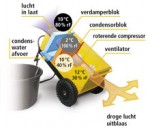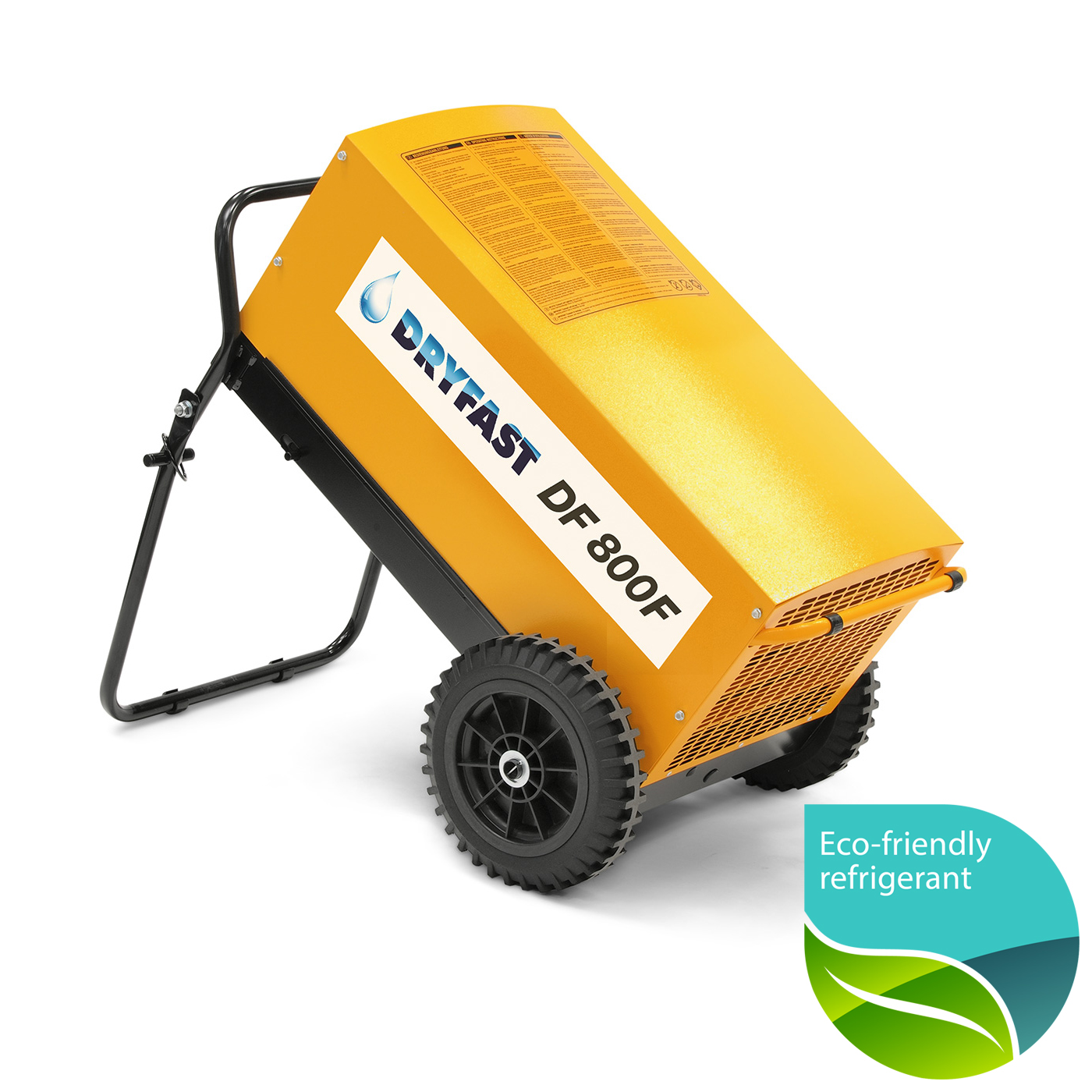Dryfast construction dryers, robust construction dryers with the greatest dehumidification capacity
Dryfast construction dryers distinguish themselves with a large dehumidification capacity, a highly robust build, a long lifespan under the most extreme of circumstances and easy maintenance. Thanks to efficient rotating compressors, our construction dryers can be transported both horizontally and vertically and can be turned on immediately. Very large numbers of these construction dryers have found their way to the rental, construction, fire and water damage repair industries in the Netherlands.
Why use a construction dryer?
The construction dryers by Dryfast can be used to accelerate the drying process. Keep in mind that some situations are not suitable for immediate use, such as in the example of screed floors. Let your screed floor harden for 7 days before using a construction dryer for active drying.

Extremely high dehumidification capacity, even at low temperatures



No electronic components without extreme protection



A robust build and extremely durable



Low power consumption due to rotating compressors



Extremely high dehumidification capacity, even at low temperatures



No electronic components without extreme protection



A robust build and extremely durable



Low power consumption due to rotating compressors
How a construction dryer works


In a construction dryer, environmentally friendly refrigerant is compressed by a rotating compressor.The hot refrigerant enters the condenser under high pressure where the gas is cooled and condensed. The environmentally friendly R454C refrigerant is injected into the evaporator where it evaporates. This requires heat which is extracted from passing air. The refrigerant is sucked back into the compressor and the cycle starts again. Humid air from the room is sucked over the evaporator where it is chilled drastically, causing the water in the air to condense. The water is drained via a descending water hose. Next, the cold air is reheated by the condenser and returned to the room as dry, warm air.
Condenser drying is a natural way of dehumidifying construction materials. If applied correctly, this natural method eliminates the risk of shrinkage cracks.
Saving costs by deploying construction dryers
The main argument for using construction dryers is their major cost savings as opposed to drying by heating, during or after construction. Construction dryers save up to 300% on heating costs in the first five years after delivery when used during the final construction phase. Another significant benefit is the fact that the construction lead time is shortened: painters, plasterers and other workers can start their work at an earlier stage and work without interruption. In addition, there are far fewer moisture problems and damage after completion.
Taking all of the above into account, construction dryers must be deployed in combination with condensation dryers.
Positioning the Dryfast construction dryers


Before deploying air dehumidifiers, the room needs to be sealed as much as possible. This means that windows, doors and other openings have to be closed off. This will prevent humid outside air from entering the room.
When using a single dehumidifier, it should be placed in the centre of the room. When deploying multiple dryers in the same room, the room is divided into several sections equal to the number of dryers. A dryer is positioned at the centre of each section to achieve optimal air distribution.
The dryers should be positioned such that the fans can blow freely without interrupting the airflow of another fan.
Construction dryers combined with heating


ATTENTION: directly powered oil and gas heaters produce a lot of moisture. approx. 0.78 litres of water is released when burning 1 litre of gas. In addition, combustion gases released into the room may cause discolouration to fresh plasterwork. It goes without saying that it is unhealthy to work in poorly or non-ventilated rooms where combustion gases are released.
Determining the necessary dehumidification capacity
With an average dehumidification capacity of 90 litres per 24 hours, the DF 800 construction dryer is best suited for drying rooms with a volume of ca. 800 m3 (at 15 °C and 75% RH). The type number of a Dryfast DF construction dryer roughly represents the number of cubic metres that it is suitable for. When large rooms are involved, without a lot of partitioning walls, the dehumidification volume can be increased by 15%. When it comes to keeping stored goods dry, the volume stated in the table can be doubled. At 10 °C, the mobile power current dehumidifier DH150GXF is suitable for a room with a volume of 3,000 m³.
Important:overcapacity relative to the necessary dehumidification capacity barely provides any time gains while elevating energy and rental costs.
We recommend getting in touch with one of our advisors for a correct capacity calculation. They will calculate your capacity needs and purchase costs as well as offer advice on how to achieve optimal results.
Estimating drying times
It is almost impossible to pinpoint exact drying times. But the deployment of the right construction dryers will certainly reduce your drying time by up to 70% in wet and cold seasons relative to natural drying. Dryfast construction dryers always create the perfect drying conditions comparable to a dry day when all windows are opened. However, these circumstances are rare in Belgium. Below you will find some indications of drying times assuming optimal drying:
- Screed; approx. 1 cm per week at a thickness of up to 4 cm. For thicker screed, please get in touch so we can make a calculation for you. Attention:for 7 days after applying the screed layer, drying cannot begin because the material still has to absorb the amount of moisture necessary for the floor to strengthen over the course of the first 30 days.
- Anhydrite cast floors; up to a thickness of 4 cm, the drying process can be completed within approx. 12 days. Provided that you start the construction drying process immediately, after 48 hours of casting the floor. For thicker floors, please get in touch so we can make a calculation for you.
- Stone walls, plasterwork and sand-lime brick blockscan be dried between 4 and 12 days
Dryfast offers a range of measurement equipment to ensure that construction materials are dry enough to start the finishing process.
Deployment of construction dryers after fire and water damage
Dryfast construction dryers are highly suited for deployment after water damage. Their high dehumidification capacity allows for the object to be dried quickly, especially when combined with mobile axial fans. More and more everyday products contain plastics, resulting in severely underestimated fire hazards. Rather than the damage caused by extinguishing water, the biggest issue is caused by the exceptionally aggressive nitric acid vapour that occurs when polyvinyl chloride (PVC) burns and reacts with humid air.
One kg of burnt PVC with a chlorine percentage of 50% generates approx. 0.4 m3 of hydrogen chloride gas, which results in a concentration of 30% hydrochloric acid when dissolved in 2 litres of water. If the right measures are not taken right away, the hydrochloric acid rains down on all bare metal surfaces (coatings tend to be burnt) of machines, computer equipment, tools, industrial robots, electrical installations, etc. with major corrosion damage as a result. This is why the cause of hydrochloric acid formation needs to be removed immediately. Which means that the chemical reaction between hydrogen chloride and humid air needs to be stopped as quickly as possible.
Corrosion is considerably reduced when air humidity is brought down to 45% RH. And by reducing the air humidity to 30% RH, corrosion can be brought to a complete halt. This can be achieved with adsorption dryers and the DF800 construction dryer.Ffitted with a hose connection piece with two connections.
Dehumidification should start as soon as extinguishing activities have been completed; the sooner the drying process begins, the lower the expected restoration costs will be.
Whether the entire room should be dried or only the objects in the room depends on the volume of the room. When drying the entire room, the air humidity in that room is reduced to less than 45% as quickly as possible in order to interrupt the process of hydrochloric acid formation. If drying the entire room is impossible due to economic or technical reasons, e.g. when only a few objects are at risk, the objects are covered with plastic canvas, for example, and dried locally underneath.
Options for condensation drain and relative humidity setting
For Dryfast construction dryers: DF200 (discontinued), DF400F, DF800Fand the DH150GX, the following options for condensed water drainage exist depending on the application:
- External water drain tray
Condensed water is caught in a water drain tray. Another option is to use an evenly descending water hose to bring the water outside or to a drainage point. - Permanent dehumidification
We recommend a dehumidifier with a built-in condensate pump for all applications that require a permanent setup. The DH150GXF, for example, comes with a condensate pump to drain condensed water. The peristaltic condensate pump is able to pump up condensed water to a maximum height of 2.5 m, allowing it to be pumped away via a skylight, for example. The DF 200, DF 400 and DF 800 construction dryers come with the option to fit them with a completely automatic condensate pump with overflow protection. Ask for these options if appropriate. - Hygrostat-controlled dehumidifiers
To avoid “excessive dehumidification” in critical applications and when low RH values and the associated higher energy costs are unnecessary, we recommend a dehumidifier fitted with a hygrostat. The hygrostat turns the dehumidifier on and off to control the RH. The DH150GXF construction dryer comes with a built-in hygrostat, the other construction dryers can be optionally fitted with an external plug-in hygrostat (except the DF800) or a built-in hygrostat.
Practical tips: optimising dehumidification capacity
For even more effective drying, it is recommended to combine our construction dryers with our axial fans from the TTV series. They come with powerful internal ventilation that greatly accelerates water evaporation from the construction materials. High airflow velocity across the surface makes the water evaporate from capillary openings in the material at a higher rate. The air dehumidifier can only extract water vapour present in the air.
TIP: Always have the mobile fan blow over the drying surface, never directly onto the surface. Corners and rooms that are difficult to reach, with little natural air displacement, require extra attention.



